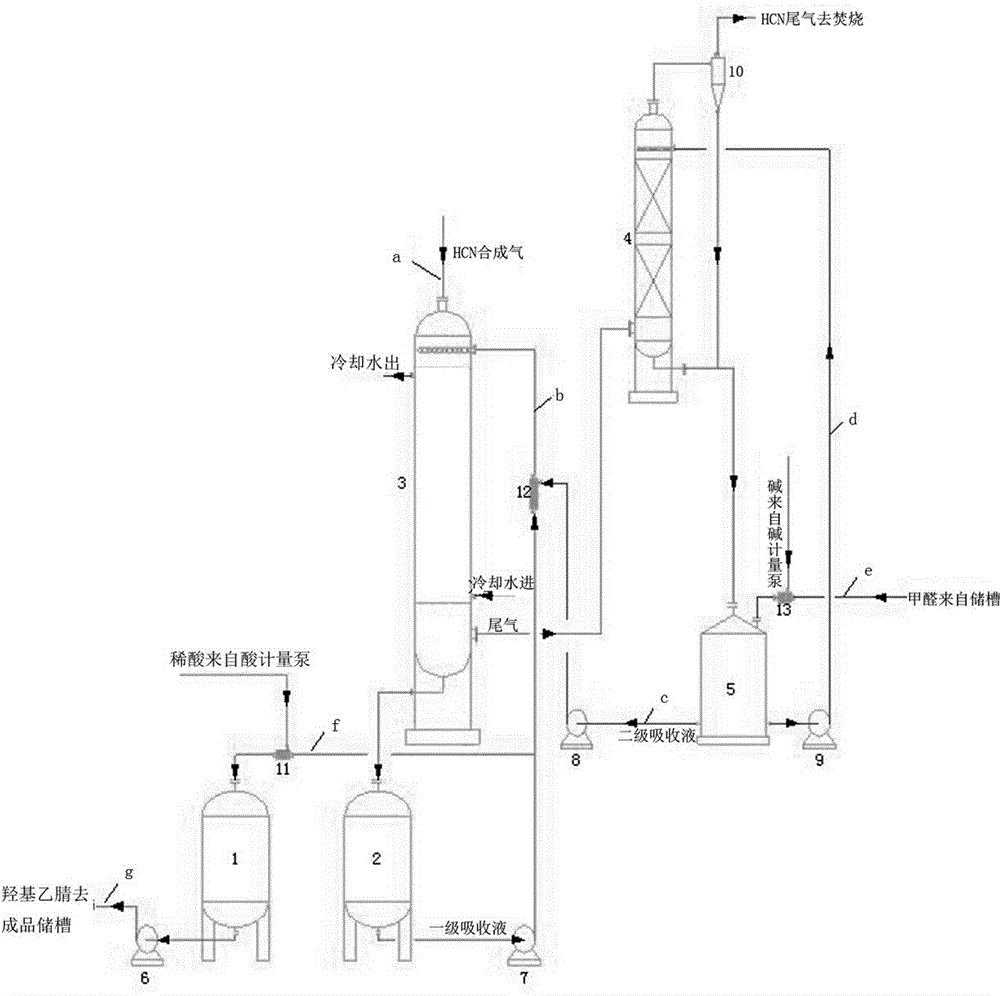Device for industrially producing hydroxyl acetonitrile
A technology of hydroxyacetonitrile and hydrocyanic acid methylolation method is applied in the field of industrial production of hydroxyacetonitrile, which can solve the problems of easy polymerization or decomposition of products, reduce the conversion rate of raw materials, reduce product quality, etc., and achieve low formaldehyde residues. , reduce exhaust emissions, high product effect
- Summary
- Abstract
- Description
- Claims
- Application Information
AI Technical Summary
Problems solved by technology
Method used
Image
Examples
Embodiment 1
[0049] Add 10m in the secondary circulation tank 5 3 formaldehyde (concentration is 10%wt), and add alkali to adjust the pH value to 6.0-6.5. The formaldehyde that adjusts the pH value in the secondary circulation tank 5 is transferred to 2m 3 In the primary circulation tank 2, start the primary reaction circulation pump 7 and the secondary reaction circulation pump 9 to beat the circulation. At the same time, HCN gas (flow velocity 22m / s) is passed into the primary and secondary reactors 3 and 4. And by adjusting the amount of cooling water so that the temperature of the liquid during the reaction is 15-20 ° C. Monitor the residual value of formaldehyde in the primary circulation tank 2 at any time, and when the residual value of formaldehyde reaches the required value (formaldehyde cannot be detected), qualified hydroxyacetonitrile is obtained.
[0050] Then, the formaldehyde feeding pump 8 is turned on to add the formaldehyde (or secondary absorption liquid) in the secon...
Embodiment 2
[0053] Add 5m to the secondary circulation tank 5 3 formaldehyde (concentration is 37%wt), and add alkali to adjust the pH value to 6.5-7.0. The formaldehyde that adjusts the pH value in the secondary circulation tank 5 is transferred to 2m 3 In the primary circulation tank 2, start the primary reaction circulation pump 7 and the secondary reaction circulation pump 9 to beat the circulation. At the same time, HCN gas (flow velocity 22m / s) is passed into the primary and secondary reactors 3 and 4. And by adjusting the amount of cooling water so that the temperature of the liquid during the reaction is 15-20 ° C. Monitor the residual value of formaldehyde in the primary circulation tank 2 at any time, and when the residual value of formaldehyde reaches the required value (formaldehyde cannot be detected), qualified hydroxyacetonitrile is obtained.
[0054]Then, the formaldehyde feeding pump 8 is turned on to add the formaldehyde (or secondary absorption liquid) in the seconda...
Embodiment 3
[0057] Add 5m to the secondary circulation tank 5 3 (50%wt) formaldehyde, and add alkali to adjust the pH value to 6.5-7.0. The formaldehyde that adjusts the pH value in the secondary circulation tank 5 is transferred to 2m 3 In the primary circulation tank 2, start the primary reaction circulation pump 7 and the secondary reaction circulation pump 9 to beat the circulation. At the same time, HCN gas (flow velocity 22m / s) is passed into the primary and secondary reactors 3 and 4. And by adjusting the amount of cooling water so that the temperature of the liquid during the reaction is 15-20 ° C. Monitor the residual value of formaldehyde in the primary circulation tank 2 at any time, and when the residual value of formaldehyde reaches the required value (formaldehyde cannot be detected), qualified hydroxyacetonitrile is obtained.
[0058] Then, turn on the formaldehyde feeding pump 8 to add formaldehyde (or the secondary absorption liquid) in the secondary circulation tank 5...
PUM
 Login to View More
Login to View More Abstract
Description
Claims
Application Information
 Login to View More
Login to View More - R&D
- Intellectual Property
- Life Sciences
- Materials
- Tech Scout
- Unparalleled Data Quality
- Higher Quality Content
- 60% Fewer Hallucinations
Browse by: Latest US Patents, China's latest patents, Technical Efficacy Thesaurus, Application Domain, Technology Topic, Popular Technical Reports.
© 2025 PatSnap. All rights reserved.Legal|Privacy policy|Modern Slavery Act Transparency Statement|Sitemap|About US| Contact US: help@patsnap.com

